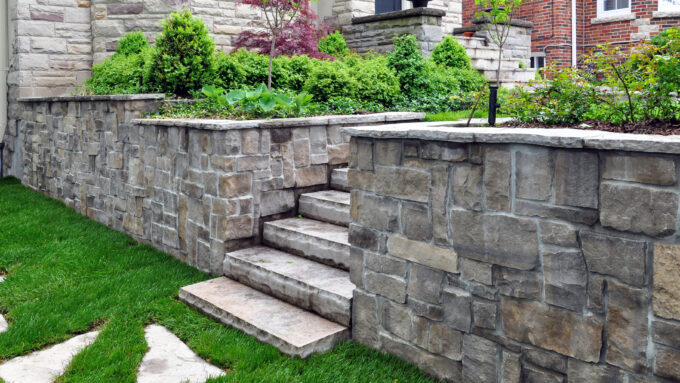Leading Advantages of Specialist Retaining Walls Sunshine Coast for Your Property
Leading Advantages of Specialist Retaining Walls Sunshine Coast for Your Property
Blog Article
Enhancing Property Stability: The Function of Retaining Walls in Dirt Retention and Disintegration Control
Keeping walls stand as quiet guardians, playing a vital function in dirt retention and disintegration control. By exploring the subtleties of various types, layout considerations, construction strategies, and maintenance tips connected with keeping wall surfaces, a deeper understanding of their pivotal function in enhancing residential or commercial property stability arises.
Relevance of Retaining Walls in Stability
The value of keeping wall surfaces in ensuring stability within landscapes can not be overemphasized. Keeping wall surfaces play a crucial function in keeping back soil, avoiding disintegration, and creating level surfaces in sloped areas. By giving structural support, maintaining wall surfaces aid to redistribute lateral stress created by soil, avoiding landslides and slippage. In enhancement to boosting the visual appeal of a building, retaining walls contribute to the general safety and security and capability of outdoor spaces.
Retaining walls are particularly important in irregular or sloping surfaces where dirt disintegration is a typical incident. Without appropriate assistance, dirt disintegration can bring about the destruction of landscapes, endangering the honesty of frameworks and posing dangers to citizens. Preserving walls serve as obstacles, maintaining the dirt and stopping it from changing downhill during heavy rains or other environmental stressors.
Moreover, maintaining walls provide long-lasting benefits by minimizing upkeep expenses related to soil erosion and land instability. By purchasing properly designed keeping wall surfaces, homeowner can guarantee the long life and sustainability of their landscapes while advertising a safe and aesthetically attractive environment.

Kinds Of Retaining Walls for Erosion Control
Gravity keeping wall surfaces are sturdy structures that rely on their weight to stand up to the pressure of the soil behind them. Cantilever preserving walls, on the other hand, are created with a thicker base and make use of a lever arm to stand up to the dirt stress.
For taller walls or where space is a constraint, anchored retaining walls are typically utilized. When choosing the suitable type of retaining wall surface for disintegration control, variables such as dirt make-up, wall surface height, and site conditions should be thoroughly considered to ensure long-lasting security and efficiency.
Style Considerations for Soil Retention
The elevation and area of the maintaining wall are essential elements that influence the general layout. Engineers need to also think about the stress exerted by the preserved soil and possible lateral tons to make certain the structure's stability over time.
Furthermore, the material choice for the preserving wall is important in boosting long life and functionality. Concrete, wood, gabion baskets, and natural stone are usual materials used in keeping wall surface construction, each with its distinct advantages and factors to consider. Proper drain devices, such as weep openings and French drains, need to be incorporated into the design to avoid water build-up behind the wall surface, which can cause architectural failing and top article disintegration.
Building And Construction Strategies for Retaining Walls
When applying style considerations for effective dirt retention, the building techniques for retaining wall surfaces play a vital function in ensuring architectural stability and long-term security. One typical technique is the gravity wall surface, which depends on the weight and mass of the wall surface itself to withstand the pressure of the preserved soil.
Another extensively used building and construction method is the cantilevered wall, which makes use of a concrete slab structure that prolongs in reverse into the preserved soil. This design supplies additional security and is suitable for tool to high keeping wall surfaces. For taller structures, enhanced soil methods such as making use of geogrids or dirt nails can be employed to improve the wall surface's stamina and security.

Maintenance Tips for Property Stability
To guarantee long-term residential or commercial property stability, normal upkeep methods are vital for preserving the honesty of preserving wall surfaces and avoiding disintegration concerns. Cleaning up the surface of the preserving wall surfaces can also aid preserve their structural honesty by eliminating dirt, particles, and plants that could deteriorate the wall view it over time.
In enhancement to visual examinations and cleansing, it is very important to inspect the drainage systems related to the maintaining walls. Making certain that drains are free from obstructions and operating correctly can prevent water accumulation behind the wall surfaces, which can bring about pressure and possible failing. Appropriately functioning drain systems are essential for handling water circulation and decreasing the threat of erosion.
Regularly checking and maintaining keeping wall surfaces according to these tips can prolong their life-span and add to the general security of the home.
Verdict
In conclusion, keeping wall surfaces play a crucial role in improving property stability by stopping dirt disintegration and retaining soil in place. By using various sorts of preserving walls and considering layout and construction techniques, home proprietors can properly regulate disintegration and keep the integrity of their land. Regular maintenance of retaining walls is important to guarantee long-lasting security and defense versus erosion. Correctly built and maintained keeping walls are key elements in preserving property security.
For taller walls or where room is a restriction, anchored preserving wall surfaces are frequently employed. These wall surfaces use cables or strips that are secured into the dirt or rock behind the wall to provide added support. When selecting the proper type of preserving wall for erosion control, aspects such as soil make-up, wall surface elevation, and website problems need to be carefully taken into consideration to my response guarantee long-lasting stability and effectiveness.
One typical technique is the gravity wall, which relies on the weight and mass of the wall itself to stand up to the pressure of the retained soil. Cleansing the surface of the preserving walls can likewise aid preserve their architectural stability by getting rid of dirt, particles, and greenery that can weaken the wall over time.
Report this page